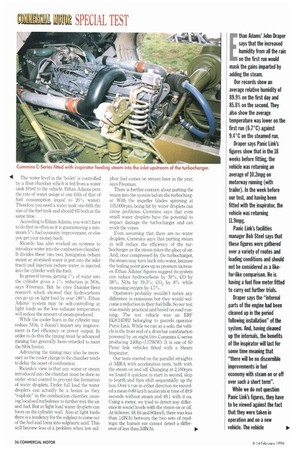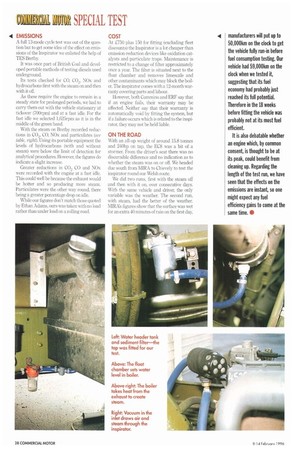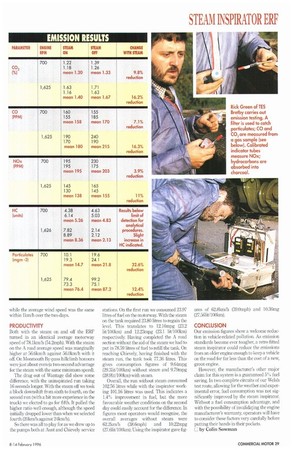STEAM
Page 26

Page 28

Page 30

Page 31

Page 29

If you've noticed an error in this article please click here to report it so we can fix it.
CLEANER
Any device guaranteed to cut your fuel consumption by at least 5% while cleaning up your exhaust emissions has to be worth a look. Was it too good to be true? There was only one way to find out.
What would ER Paden have made of it? In the face of an industry dominated by steam he built ERF's "with oil engines"—or diesels to you and me. Now someone has produced a device to put steam back into his beloved diesel engines,
The Steam Inspirator is a device invented and patented by Karl Meganbier. It is manufactured by IBS (Inspired By Steam) and marketed by SPA (Steam Producing Aspirator). Both companies belong to Ethan Adams.
The system uses heat from the exhaust to turn water into low-pressure steam which is fed into the engine's air intake. This, says Ethan Adams, not only reduces emissions, but also improves fuel economy. We took a laden ERF EC8 for a couple of laps of our Welsh middleweight route and subjected it to some emission testing to try it out.
The theory of introducing water into the combustion chamber is perfectly sound, says Hamish Freeman, principal engineer (heavy duty engines) of Ricardo Consulting Engineers. NOx is a big problem with diesel engines. It is formed by a combination of pressures and heat in the combustion chamber.
To meet emission limits engine manufacturers are retarding the start of injection (which makes the engine less fuel efficient). Introducing water, or steam, lowers the flame temperature and so inhibits the formation of NOx.
The simplicity of Ethan Adams' system has much to commend it. A water jacket is fitted round the exhaust just after the turbocharger, and the steam it produces is drawn in by the depression in the inlet manifold.
When no steam is being produced, an inspirator is used. This can be thought of as a secondary filter feeding air through a pipe and tapping into the ducting leading from the main filter to the turbocharger, So when there is plenty of steam, it fills the pipe to the inlet trunking. If not, any air drawn in through the tapping is filtered to remove any damaging containments. • The water level in the 'boiler' is controlled by a float chamber which is fed from a water tank fitted to the vehicle. Ethan Adams puts the rate of water usage at one fifth of that of fuel consumption (equal to 20% water). Therefore you need a water tank one-fifth the size of the fuel tank and should fill both at the same time.
According to Ethan Adams, you won't have to do that as often as it is guaranteeing a minimum 5"0 fuel economy improvement, or else you get your money back.
Ricardo has also worked on systems to introduce water into the combustion chamber. It divides these into two; fumigation (where steam or atomised water is put into the inlet tract) and injection (where water is injected into the cylinder with the fuel).
In general terms, getting 1% of water into the cylinder gives a 1% reduction in NOx, says Freeman. But he cites Daimler-Benz research which showed that hydrocarbons can go up on light load by over 180%. Ethan Adams' system may be self-controlling at light loads as the low exhaust temperature will reduce the amount of steam produced.
While the cooler burn in the cylinder may reduce NOx, it doesn't impart any improvement in fuel efficiency or power output. In order to do this the timing must be advanced (timing has generally been retarded to meet the NOx limits).
Advancing the timing may also be necessary as the cooler charge in the chamber tends to delay the onset of combustion.
Ricardo's view is that any water or steam introduced into the chamber must be done so under strict control to prevent the formation of water droplets. Under full load the water droplets can actually be a bonus as they "explode" in the combustion chamber, causing localised turbulence to further mix the air and fuel. But at light load water droplets can form on the cylinder wall. Also at light loads there is a tendency for the sulphur to come out of the fuel and form into sulphuric acid. This will become less of a problem when low sul phur fuel comes on stream later in the year, says Freeman.
There is further concern about putting the steam into the system before the turbocharger. With the impeller blades spinning at 105.000rpm, being hit by water droplets can cause problems. Cummins says that even small water droplets have the potential to impact damage the turbocharger and can erode the vanes
Even assuming that there are no water droplets. Cummins says that putting steam in will reduce the efficiency of the turbocharger as the steam takes the place of air. And, once compressed by the turbocharger, the steam may turn back into water, because the boiling point goes up as pressure increases. Ethan Adams' figures suggest its system can reduce hydrocarbons by 39%, CO by 38%, NOx by 19.3%; CO2 by 8% while increasing oxygen by 4.7%.
Operators probably wouldn't notice any difference in emissions but they would welcome a reduction in their fuel bills. So our test was mainly practical and based on road running. The test vehicle was an ERF EC8.24DB2 belonging to parcels operator Panic Link. While we ran as a solo, the vehicle is the front end of a drawbar combination powered by an eight-litre Cummins C-series producing 240hp (1179kW). It is one of 60 Panic link vehicles fitted with a Steam Inspirator.
Our tests started on the parallel straights at MIRA with acceleration tests, both with the steam on and off Changing at 2,100rpm we found it quickest to start in second, skip to fourth and then shift sequentially up the box. Over a run in either direction we recorded a mean 0-80 km/h acceleration time of 49.9 seconds without steam and 49.1 with it on. Using a meter, we tried to detect any difference in sound levels with the steam on or off. At tickover, 48,64 and 80km/h, there was less than ldB(A) between the two sets of readings: the human ear cannot detect a difference of less than 3dB(A).
• EMISSIONS
A full 13-mode cycle test was out of the question but to get some idea of the effect on emissions of the Inspirator we enlisted the help of TES Bretby.
It was once part of British Coal and developed portable methods of testing diesels used underground.
Its tests checked for CO, CO2, NOx and hydrocarbons first with the steam on and then with it off.
As these require the engine to remain in a steady state for prolonged periods, we had to carry them out with the vehicle stationary at tickover (700rpm) and at a fast idle. For the fast idle we selected 1,625rpm as it is in the middle of the green band.
With the steam on Bretby recorded reductions in CO.,, CO, NOx and particulates (see table, right). Using its portable equipment the levels of hydrocarbons (with and without steam) were below the limit of detection for analytical procedures However, the figures do indicate a slight increase.
Greater reductions in CO2 CO and NOx were recorded with the engine at a fast idle. This could well be because the exhaust would be hotter and so producing more steam. Particulates were the other way round, there being a greater percentage drop on idle.
While our figures don't match those quoted by Ethan Adams, ours was taken with no load rather than under load on a rolling road. COST At 050 plus 150 for fitting (excluding fleet discounts) the Inspirator is a lot cheaper than emission-reduction devices like oxidation catalysts and particulate traps. Maintenance is restricted to a change of filter approximately once a year. The filter is situated next to the float chamber and removes limescale and other contaminants which may block the boiler. The inspirator comes with a 12-month warranty covering parts and labour.
However, both Cummins and ERF say that if an engine fails, their warranty may be affected. Neither say that their warranty is automatically void by fitting the system, but if a failure occurs which is related to the inspirator, they may not be held liable.
ON THE ROAD
With an all-up weight of around 15.8 tonnes and 240hp on tap, the EC8 was a bit of a stormer. From the driver's seat there was no discernible difference and no indication as to whether the steam was on or off. We headed due south from MIRA to Chievely to test the inspirator round our Welsh route.
We did two runs, first with the steam off and then with it on, over consecutive days. With the same vehicle and driver, the only variable was the weather. The second run, with steam, had the better of the weather. MIRA's figures show that the surface was wet for an extra 40 minutes of rain on the first day, while the average wind speed was the same within lkinfli over the two days.
PRODUCTIVITY Both with the steam on and off the EU turned in an identical average motorway speed of 78.1km/h (54.2mph). With the steam on the A road average speed was marginally higher at 56.6km/h against 56.0km/h with it off. On Monmouth By-pass hillclimb honours were just about even (a two-second advantage for the steam with the same minimum speed).
The drag out of Wantage did show some difference, with the uninspirated run taking 16 seconds longer. With the steam off we took a block downshift from sixth to fourth, on the second run (with a bit more experience in the truck) we elected to go for fifth. It pulled the higher ratio well enough, although the speed initially dropped lower than when we selected fourth (20krn/h against 24kmili).
So there was all to play for as we drew up to the pumps both at Aust and Chievely service
stations. On the first run we consumed 23.97 litres of fuel on the motorway. With the steam on the tank required 23.80 litres to regain the level. This translates to 12.16mpg (23.2 lit/100km) and 12,23mpg (23,1 lit/100km) respectively. Having completed the A road section without the aid of the steam we had to put in 78.59 litres of fuel to refill the tank, On reaching Chievely, having finished with the steam run, the tank took 77.36 litres. This gives consumption figures of 9.64mpg (29.31it/100km) without steam and 9.79mpg (28.91it/100km) with steam.
Overall, the run without steam consumed 102.56 litres while with the inspirator working 101.16 litres was used. This indicates a 1.4% improvement in fuel, but the more favourable weather conditions on the second day could easily account for the difference. In figures most operators would recognise, the overall averages without steam were 62.2krn/h (38.6mpb) and 10.22mpg (27.61it/100km). Using the inspirator gave fig
ures of 62.8km/h (39.0mph) and 10.36mg (27.561it/100km).
CONCLUSION
Our emission figures show a welcome reduction in vehicle-related pollution. As emission standards become ever tougher, a retro-fitted steam inspirator could reduce the emissions from an older engine enough to keep a vehicle on the road for far less than the cost of a new, green engine.
However, the manufacturer's other major claim for this system is a guaranteed 5% fuel saving. In two complete circuits of our Welsh test route, allowing for the weather and experimental error, fuel consumption was not significantly improved by the steam inspirator. Without a fuel consumption advantage, and with the possibility of invalidating the engine manufacturer's warranty, operators will have to consider these factors very carefully before putting their hands in their pockets.
L by Colin Sowman Price of inspirator: £900 including fitting charge (ex-VAT). Engine: 8.3 litres, 240hp (179kW).
GVW: 17 tonnes. Body/payload: 11.46 tonnes. Speeds: With steam, 62.8km/h; without steam, 62.2km/h. Fuel consumption: With steam, 10.36mpg; without steam, 10.22mpg. than Adams' John Draper says that the increased humidity from all the rain on the first run would mask the gains imparted by adding the steam.
Our records show an average relative humidity of 89.9'4 on the first day and 85.84 on the second. They also show the average temperature was lower on the first run (6.7°C) against 9.4°C on the steamed run.
Draper says Panic Link's figures show that in the 18 weeks before fitting, the vehicle was returning an average of 10.2mpg on motorway running (with trailer). In the week before our test, and having been fitted with the inspirator, the vehicle was returning 11.9mpg.
Panic Link's facilities manager Bob Steel says that these figures were gathered over a variety of routes and loading conditions and should not be considered as a likefor-like comparison. He is having a fuel flow meter fitted to carry out further trials.
Draper says the "internal parts of the engine had been cleaned up in the period following installation" of the system. And, having cleaned up the internals, the benefits of the inspirator will last for some time meaning that "there will be no discernible improvements in fuel economy with steam on or off over such a short term".
While we do not question Panic Link's figures, they have to be viewed against the fact that they were taken in operation and on a new vehicle. The vehicle manufacturers will put up to 50,000km on the clock to get the vehicle fully run-in before fuel consumption testing. Our vehicle had 59,000km on the clock when we tested it, suggesting that its fuel economy had probably just reached its full potential. Therefore in the 18 weeks before fitting the vehicle was probably not at its most fuel efficient.
It is also debatable whether an engine which, by common consent, is thought to be at its peak, could benefit from cleaning up. Regarding the length of the test run, we have seen that the effects on the emissions are instant, so one might expect any fuel efficiency gains to come at the same time.
SPECIFICATION
11MI ERF EC8.24DB2 4x2 drawbar prime mover with day cob.
Design GVW 18 tonnes.
Manufacturer: ERF Limited, Sun Works, Sandbach, Cheshire CW11 9DN, REM Cummins C 6CT5A240 four-strake direct injection diesel with turbocharger and charge cooler. Cylinders: Six in-line.
Bore/stroke: 1 I 4x135mm.
Capacity: 8 3 litres.
Compression ratio: 17.3:1.
Maximum net power: 240hp (179kW) ai 2,150 rpm to ECE 24.03.
Maximum net torque: 71511uft (969Nrn) all,350 rpm to ECE
2403.
n1ri=21 Eaton 6109A nine-speed synchromesh gearbox Find drive: Rockwell 5153E single-reduction axle with dlfhlock. Ratio 4.1:1.
Optional ratios. 3.91:1.
Clutch: Twin plate ceramic, 365mm diameter.
BRAKING SYSTEMS: Full air, dual line with load sensing and ABS Air reservoirs: 4x30 Parking. Spring brakes on the rear axle and trailer (when coupled).
Engine brake: Butterfly-type exhaust brake as standard. Brake dimensions: front and rear' 410x200mm.
STEEP IN: ZF recirculating boll with integral power assistance.
NENE Pressed-steel channel with channel cross-members. Side members: 270x7x85mm.
Suspension. Front and rear, taper-leaf springs with telescopic dampers and anti-roll bar. Wheelbase: 5.8m.
Axle design weights: front 8.0 tonnes. Rear 11.5 tonnes. Plated axle weights: front 7.1 tonnes. Rear 10.5 tonnes. Design GTW: 32.52 tonnes.
Wheels and lyres: Front Goodyear 295/80R22.5 on 8.25x22.5 rims; rear 11 R22.5 on 7.5x22.5 rims, Fuel lank: 204 litres 45 gallonsF_ nEtEliMEM 24V insulated return. Battery 2x I 2V I 20Ah batteries. Generator: 55 A alternator.
Pickerings dry-freight body.
TERMS OF WARRANTY: Two years unlimited mileage parts and labour warrmly DEALERS AND SERVICE POINTS ERF has 86 distributors, dealers and service repairers in the UK. Through its Continental network and Green Flag, ERF hos 3,000 service outlets.
HILL PERFORMANCE WITHOUT STEAM WITH STEAM Hill min sec min sec Monmouth By-pass 2 44 2 42 Wan tage 2 55 2 39 ACCELERATION WITHOUT STEAM WITH STEAM km/h sec sec (gear) 0-80 219.9 49,1 32-64 19.2 19,4 5 & 6 48-80 28.7 28.5 6 Ss 7 OPERATIONAL TRIAL RESULTS
Welsh route: 362.8km (103.1km motorway/259.7km A-road). WITHOUT STEAM-Motorway: Speed, 87.1km/h (54.2mph); fuel consumption, 12.16mpg (23.214/100km). A-road: Speed, 56.0km/h (34.9mph); fuel consumption, 9.64mpg (29.314/100km). Overall: Speed, 62.2km/h (38.6mph); fuel consumption, 10.22mpg (27.61it/100km). WITH STEAM-Motorway: Speed 87.1 km/h (54.2rnph), fuel consumption: 12.23mpg (23.1lit/100km) A-road: Speed 56.6km/h (35.2mph), fuel consumption: 9.79mpg (28.91it/100km). Overall: Speed, 62.8km/h (39.0mph); fuel consumption, 10.36mpg (27.5614/100km).
IN-CAB NOISE WITHOUT STEAM WITH STEAM
km/h &MA) dB(A) rpm 48 67.3 67.0 1,400
64 68.2 68.6 1,400 80 71.1 71.4 1,650




































































































